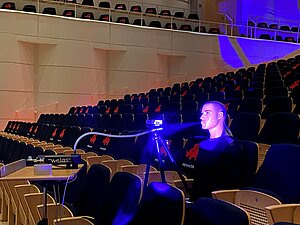November 12, 2020

Researchers from Fraunhofer Heinrich Hertz Institute (HHI) have investigated the spread of aerosols and CO2 in a concert hall. The measurements were carried out in collaboration with Parteq, a company that specializes in measurement technology, within the scope of a study conducted by Dortmund concert hall. The objective was to obtain experimental data to assess the risk potential of catching a corona infection during a concert visit.
The temporary closure of all cultural facilities due to new pandemic regulations has made Dortmund Concert Hall the first cultural institution in Germany to examine the infection probability in concert halls under adherence to safety measures. For the study a Fraunhofer HHI research team conducted several experiments to measure the dissemination of aerosols and CO2 in Dortmund concert hall. Various studies on aerosol emissions during singing and music making with wind instruments have been executed. This one is the first study that experimentally investigates the spread of aerosols and CO2 within an auditorium.
The project is lead by Prof. Dr. Wolfgang Schade, head of the department Fiber Optic Sensor Systems at Fraunhofer HHI in Goslar. The experiment’s central element is the dummy "Oleg" who is sitting in the auditorium spreading precisely defined amounts of aerosols and CO2 through a tube from the mouth and nose - thus simulating normal human breathing of a spectator. The dissemination of aerosols (diameter of a few hundred nanometers to micrometers) is measured with and without a mask taking into account various effecting scenarios, such as the thermal effect of the audience sitting around the dummy. For this purpose, members of the Dortmund Philharmonic Orchestra were asked to sit in the parquet floor during a rehearsal.
The size and composition of emitted aerosol particles change depending on ambient conditions; for example, particles shrink when they pass from the respiratory tract into the ambient air due to evaporation of contained water. In particular, the ventilation and temperature of the concert hall have a decisive influence on the dissemination of particles and CO2 emissions. The processes that lead to the formation and alteration of aerosol and CO2 concentrations depend on a multitude of different factors and can hardly be predicted in individual cases. "We would like to find out what the contamination in the vicinity of the dummy is like, in order to deduce if people in the vicinity could be fundamentally at risk or not," said Prof. Dr. Schade.
First evaluations of the experiments at Dortmund Concert Hall already indicate that the installed ventilation system produces considerable dilution effects of concentrated aerosols and CO2 even over very short distances. The results of the investigations should contribute to a risk assessment of infection with Sars-CoV-2 viruses when attending concerts on basis of experimentally obtained data. Whether the findings can be transferred to other cultural institutions or whether similar measurements need to be carried out at other locations is not yet clear. Moreover, the study results could provide valuable contributions to risk assessment concering the ventilation of classrooms in schools and university lecture halls.